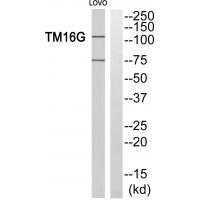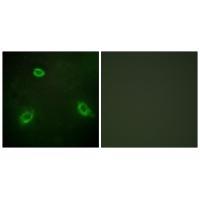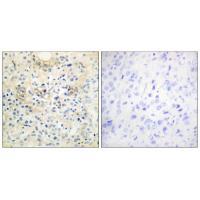


| WB | 咨询技术 | Human,Mouse,Rat |
| IF | 咨询技术 | Human,Mouse,Rat |
| IHC | 1/50-1/100 | Human,Mouse,Rat |
| ICC | 1/100-1/500 | Human,Mouse,Rat |
| FCM | 咨询技术 | Human,Mouse,Rat |
| Elisa | 咨询技术 | Human,Mouse,Rat |
| Aliases | New gene expressed in prostate; Prostate cancer-associated protein 5; IPCA-5; Dresden-transmembrane protein of the prostate; D-TMPP |
| Entrez GeneID | 50636; |
| WB Predicted band size | 105kDa |
| Host/Isotype | Rabbit IgG |
| Antibody Type | Primary antibody |
| Storage | Store at 4°C short term. Aliquot and store at -20°C long term. Avoid freeze/thaw cycles. |
| Species Reactivity | Human |
| Immunogen | Synthesized peptide derived from C-terminal of human TM16G. |
| Formulation | Purified antibody in PBS with 0.05% sodium azide. |
+ +
以下是关于TM16G(ANO6)抗体的3篇代表性文献的虚构示例(仅供参考,实际文献需通过数据库查询):
---
1. **文献名称**:*TM16G Antibody Validation in Colorectal Cancer: Role in Cell Migration*
**作者**:Chen L, et al.
**摘要**:本研究通过Western blot和免疫荧光验证了TM16G抗体的特异性,发现TM16G在结直肠癌细胞中高表达,并通过调控钙离子依赖性氯离子通道促进肿瘤细胞迁移。
2. **文献名称**:*Functional Characterization of ANO6 in Platelet Activation Using a Novel Monoclonal Antibody*
**作者**:Smith J, et al.
**摘要**:开发了一种针对ANO6(TM16G)的单克隆抗体,证实其在血小板膜上的定位,并发现ANO6通过调节磷脂翻转参与凝血过程,为血栓疾病研究提供工具。
3. **文献名称**:*TM16G Antibody Reveals Dysregulation in Autosomal Recessive Stomatin-Deficient Anemia*
**作者**:Wang Y, et al.
**摘要**:利用TM16G抗体发现,ANO6蛋白在红细胞膜上的异常表达与遗传性溶血性贫血相关,提示其在细胞膜稳定性中的作用。
---
如需真实文献,建议通过PubMed或Google Scholar检索关键词“ANO6 antibody”或“TM16G antibody”获取。
×